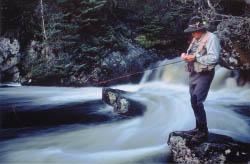Drain on Water

By Chris Marshall
It's been a dry year here in eastern Ontario. Throughout the summer, I've watched
my local river gradually dry up. By the end of August it was little more than a
trickle and most of my favourite runs and pockets were unfishable.
This is not a new phenomenon: in most parts of the country we're used to our
rivers shrinking in summer - it's an inevitable and natural effect of climate. Even
though such conditions can severely constrain our fishing opportunities, we tend to
shrug our shoulders and, like good Canadians, wait for things to get better.
It's not that we're complacent about threats to the rivers which sutain our sport.
Far from it - many of us sweat blood and tears in the constant battle against
over-exploitation of game fish and the rivers, lake and oceans which sustain
them; against agricultural and industrial practices which despoil watersheds and
coastlines. Although we've not always been victorious, considering what we're up
against we can be proud of what we've accomplished. But because we expect
river flows to diminish during the summer, while we might complain, we tend to
accept the situation stoically.
However, reduction in water flows are not entirely due to natural causes: farmers
pump from them to irrigate their crops, we dam them to store water, and private
and municipal wells tap into the aquifers which sustain feeder springs. These
activities have been with us for a long time and, as their effects are much more
subtle than the traumatic spectacle of a cyanide spill or seine nets blocking the
mouth of a river, we are less sensitive to them. Nevertheless, extraction is a
very real threat to the existence of the rivers we fish, particularly trout and salmon
rivers, and it is rapidly becoming an even greater threat.
As I watched by river dwindling away this past summer, there was a feature
in our local newspaper about two new commercial water bottling plants which
were starting up locally. One of them was planning to tap a spring which ran
into my river - to the tune of a million and a half litres per day. As the historical
summer low flow on the river is about 35 million litres a day, this doesn't seem
like much (about 5.8%), but just one more such operation in the watershed
would double this to 11.6% - two more, and the figure is closer to 20%.
These figures are significant. Moreover, water bottling operations target spring
water - the cold, relatively uncontaminated underground sources which are the
lifeblood of rivers. For they provide more than just volume. They supply cool
water and help sustain levels of dissolved oxygen in the dog days. They also sustain
cool tributary springs which, on many of our stressed rivers, are the
only places where trout and salmon can viably reproduce.
Demand for bottled water is increasing and will continue to increase. Coupled
with increased municipal and domestic consumption from wells and springs,
the threat to our cold water fisheries is frightening - especially when natural
variation in climate (such as we've experienced in the eastern half of the country
this summer) engender drought.
One of our local bottlers justified his operation by claiming that he was "bottling
what would . . . run away and be lost." Unfortunately, this attitude is widespread.
We need to tackle the problem immediately and powerfully. Otherwise, the time
will come when all I will be able to claim for my valley is that a trickle runs through
it. And I won't be alone.
~ Chris Marshall
|







